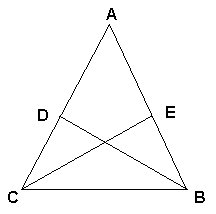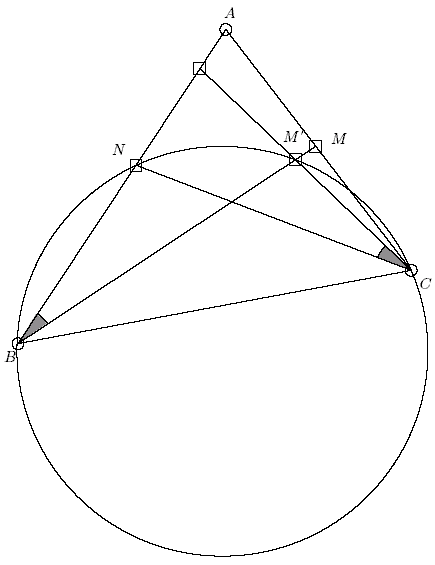
[HOME - BASE Cinque - Appunti di Matematica ricreativa]
Se in un triangolo due bisettrici sono uguali allora il triangolo è isoscele
Ringrazio Nicola per aver inviato questo problema al Forum.
Sono più che certo che una
dimostrazione puramente sintetica (quindi Euclidea) debba esistere per questo
teorema che è l'inverso del teorema sulle bisettrici di un triangolo isoscele.
Dei colleghi mi hanno proposto già una dimostrazione trigonometrica, ma a me
non interessa una soluzione che non sia di tipo euclideo: per me il teorema fa
parte di quella geometria e DEVE esserci una tale soluzione. Chiedo, per questo,
l'aiuto degli amici di Base5 ai quali giunge già il mio ringraziamento. Questo
l'enunciato del teorema.
Se in un triangolo le bisettrici degli angoli
alla base sono congruenti, allora il triangolo è isoscele.
Teoremi diretti:
Se un triangolo è isoscele, allora
Teoremi inversi:
Il teorema di Steiner-Lehmus è proprio l'ultimo dei teoremi inversi:
Se in un triangolo due bisettrici sono uguali allora il triangolo è
isoscele.
Nota: il teorema di Steiner-Lehmus è sempre dimostrato per assurdo. John
Horton Conway ha (avrebbe?) dimostrato che questo teorema non può avere una
dimostrazione diretta.
E' una sfida?
O è l'ineluttabile realtà?
Note storiche:
Daniel Christian Ludolf Lehmus, matematico tedesco, (1780-1863).
Jakob Steiner, il mitico geometra svizzero (1796-1863) imparò a leggere
e a scrivere a 14 anni e iniziò a frequentare la scuola a 18 anni.
Nella "Cronologia della Matematica
ricreativa" di David Singmaster si trova la seguente nota:
"1840 - Lehmus poses Steiner-Lehmus Theorem to Steiner."
"Un problema del genere, sul quale invito
a riflettere, non è per niente un problema facile nonostante la formulazione
sia semplicissima. Il risultato si chiama tradizionalmente Teorema di
Steiner-Lehmus; la prima dimostrazione risale al 1844, dovuta a Steiner,
proprio su sollecitazione di Lehmus che ne trovò un’altra nel 1850. La prima
dimostrazione diretta è del 1970."
Enrico Gregorio, NOTE PER IL CORSO DI DIDATTICA DELLA MATEMATICA II, Note
scritte per la SSIS Veneto, anno accademico 2004-2005.
Agosto 2005
Ho trovato una dimostrazione assolutamente fulminante del
teorema di Steiner-Lehmus.
Si trova nel bellissimo testo portoghese:
Introducciò a la Geometria, di Gabriel Cardona Juanals, 29 d’abril de 2004
(il file .pdf si può scaricare qui: Introduccio a la
Geometria http://dmi.uib.es/~gcardona/geometria/apunts.pdf)
E' una ricostruzione della dimostrazione di Coxeter tratta da Geometry revisited, di H.S.M. Coxeter e S.L. Greitzer.
Spero che vi dia la soddisfazione che ha dato a me.
La dimostrazione si basa su due lemmi.
Lemma 1. (di normale amministrazione)
Se due corde di una circonferenza corrispondono ad angoli al centro diversi
allora ad angolo maggiore corrisponde corda maggiore.
Lemma 2. (potentissimo, lo dimostro più sotto)
Se un triangolo ha due angoli diversi, allora all'angolo minore corrisponde il
segmento di bisettrice maggiore.
Il teorema di Steiner-Lehmus discende direttamente dal
lemma 2.
Se in un triangolo due bisettrici sono uguali allora il triangolo è
isoscele.

Ipotesi:
CE bisettrice di C
BD bisettrice di B
CE = BD
Dimostrazione.
Supponiamo per assurdo che il triangolo non sia isoscele.
Se il triangolo ABC non è isoscele, allora i due angoli alla base B, C sono
diversi, ad esempio B<C.
Ma allora, per il lemma 2, BE>CD, il che contraddice l'ipotesi.
CVD
Ora rimane da dimostrare il lemma 2 (utilizzando il lemma 1).
Lemma 2.
Se un triangolo ha due angoli diversi, allora all'angolo minore corrisponde il
segmento di bisettrice maggiore
Faccio riferimento alla figura qui sotto.

Dimostrazione.
Abbiamo il triangolo ABC con gli angoli B<C.
Tracciamo le bisettrici BM e CN.
Vogliamo dimostrare che:
BM>CN
Tracciamo il segmento CM' tale che l'angolo M'CN sia uguale alla metà dell'angolo B. M' è il punto in cui tale segmento incontra la bisettrice BM.
Si osserva che i quattro punti B, C, M, M' stanno tutti su una circonferenza. Infatti M'CN e M'BN sono angoli alla circonferenza uguali, che insistono sullo stesso arco NM'.
La corda CN corrisponde all'angolo alla circonferenza B
La corda BM' corrisponde all'angolo alla circonferenza C
Siccome, per ipotesi, B<C, allora:
CN<BM'
Ma, evidentemente, BM'<BM
Per la proprietà transitiva:
CN<BM
Ovvero:
BM<CN
CVD
L'articolo di John Conway tratto da:
http://www.mathematik.uni-bielefeld.de/~sillke/PUZZLES/steiner-lehmus
> Coxeter's Introduction to Geometry discusses this theorem,
> refers to it as the Stiener-Lehmus theorem, and says there are
> over 60 proofs. He gives a simple, elegant proof of the more general
> theorem that the larger of two angle bisectors intersects the
> smaller side. The proof is independant of the parallel
> postulate, and thus is also valid in hyperbolic geometry.
I've often responded to questions about why this theorem is so hard to prove by
saying that it isn't true if you allow the various lengths involved to be in
more general fields, like the complex numbers. After someone asked for details
about this the other day, I took the trouble to work everything out, and found
to my surprise that it isn't even true when you allow them to be negative reals,
which makes the situation much easier to understand.
Here's what's going on. The lengths of the A and C angle bisectors turn out to
be
root{bc(a+b+c)(b+c-a)} root{ab(a+b+c)(a+b-c)}
---------------------- and ---------------------- ,
b+c a+b
so the equality we're given is
bc(b+c-a).(a+b)^2 = ab(a+b-c).(b+c)^2
or
(c-a){ ac^2 + (a^2+3ab+b^2)c^2 + b^2(a+b) } = 0.
Now algebraically, this does not imply that c=a, because it
might be the second factor that vanishes.
However, if a,b,c are positive, then so is this second factor, and so with this
assumption we CAN deduce c = a, but only by a proof that somehow distinguishes
positive numbers from negative ones. Now the most common type of proof by a
chain of equalities, such as:
"This length equals that length, therefore those two triangles are
congruent, so this angle equals that angle, whence ... whence ultimately AB = BC."
cannot possibly do this, because it would work for all values of the variables,
and it's just not possible to deduce that c=a from
(c-a)(ac^2 + (a^2+3ab+b^2)c + b^2(a+b)} = 0.
The 60 proofs you mention avoid this by using order properties
of the reals, typically:
"Suppose AB > BC. Then this angle exceeds that angle, whence ... whence
ultimately the first angle-bisector is greater than the second. Now suppose
instead that AB < BC : this implies similarly that the second is greater than
the first. But we are given that they are equal, so the only possibility is that
AB = BC."
We can actually smoothly vary the parameters of a triangle in such a way that
one of its "edgelengths" changes sign and get a "counterexample"
to the Steiner-Lehmus theorem. Here's how:
C
/ \
E D
/ I \
/ \
A--> F <--B
Fix C, but let A and B move freely on the x-axis. Then if
they move so as to pass right through each other:
C
/ \
/ \
/ \
/ \
<--B F A-->
I
D E
it's natural to say that c has changed sign. As they moved, the
incenter I moved smoothly down, and crossed the x-axis as they passed through
each other, so that it became an excenter of the final inside-out triangle.
The angle-bisector segments AD,BE,CF of the original triangle also vary smoothly
during this process, and I've drawn the final positions that they get into in
the above picture. Now take a = b = 1;
then the above equation for c becomes
c^2 + 5c + 2 = 0,
which is satisfied by c = (-5 + root17)/2, which is about -.44 ;
then with this value of c ALL THREE of these segments are equal, but the
triangle is only isosceles, not equilateral!
If there were a proof of the Steiner-Lehmus theorem of the above equality-chasing type, it would continue to work when we varied the triangle smoothly in this way, and so would prove this triangle equilateral, which it isn't. So there's no such proof!
John Conway
Sito Web realizzato da Gianfranco Bo